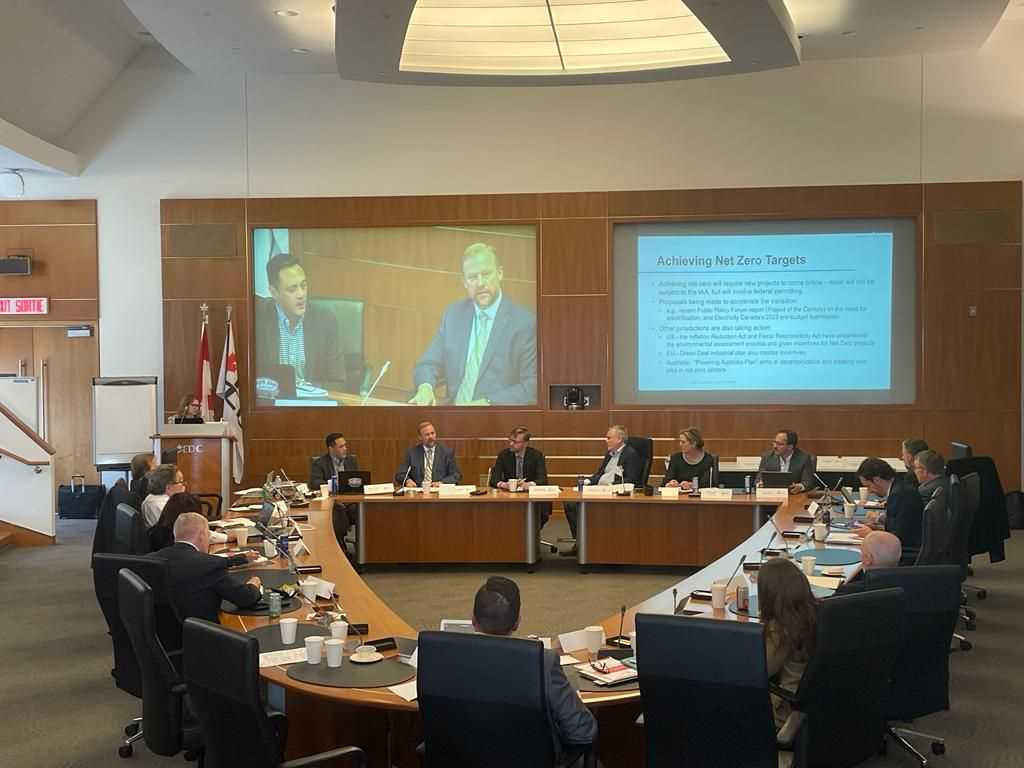Thursday, July 3, 2025
Canadians stand to benefit from major new infrastructure investments and significant environmental improvements if appropriate regulatory changes are implemented in the near future, according to a number of senior officials from Canadian energy organizations. Following a recent meeting of the National Electricity Roundtable, a range of leaders from Canada’s electricity sector released statements explaining why focusing public attention on the value of this potential is at the top of their shared priorities.
However, many of the same experts are warning that important infrastructure may be delayed or made unnecessarily costly because of regulatory uncertainties. Canadian energy regulators are facing a formidable combination of challenges to modernize their systems and grapple with growing complexities, at the same time as handling an unprecedented volume of cases in the near term. Despite considerable efforts at modernization that are already underway or completed, it’s difficult to know whether regulatory processes will in fact keep up with the speed of change in the industry.
Speaking on November 14, 2023 to a group of energy industry leaders, Philippe Dunsky, founder of Dunsky Energy + Climate Advisors and chair of the Canada Electricity Advisory Council, outlined what’s at stake. “Modernizing our regulatory systems is essential for Canada’s future prosperity: our ability to attract investment, to compete in the global marketplace, and to maintain our credibility and brand internationally, depend in large part on successfully transitioning to a low- or zero-carbon economy. And at the heart of that transition lies an unprecedented build-out of clean electricity.”

Philippe Dunsky, founder of Dunsky Energy + Climate Advisors and chair of the Canada Electricity Advisory Council.
John Gorman, president and CEO of the Canadian Nuclear Association sees hope amidst the challenges: “We have heard so many times in recent years that one of the main obstacles that stands in the way of accelerating our energy transition in Canada is the inability of our country to get things built. The recent Supreme Court decision represents a golden opportunity to make the kind of real, substantive changes that are needed to address this problem and prevent critically important projects from getting stuck unintentionally in bureaucratic processes, or mired in federal and provincial political disagreements. Thankfully, there is promising, coordinated work going on right now within the Federal Government that gives me hope that this opportunity is being seized and we’ll see some real progress in the near future.”
John Gorman, president and CEO of Canadian Nuclear Association.
Recognizing the same kinds of concerns, the federal government recently established the “Ministerial Working Group on Regulatory Efficiency for Clean Growth Projects.” The Fall Economic Statement of November 21, 2023 confirmed that this group is mandated to “improve the efficiency of the permitting and impact assessment processes for major projects, which will include clarifying and reducing timelines, mitigating inefficiencies, and improving engagement and partnerships.” A “concrete plan” was slated for release by the end of 2023.
This group is expected to build on the work of the Energy Transformation Task Force announced by Prime Minister Justin Trudeau and U.S. President Joe Biden on March 24, 2023. It will “focus on securing and strengthening renewable energy and electric vehicle supply chains, critical minerals and rare earths, grid integration and resilience, advanced and conventional nuclear energy, among other areas that advance our collective energy security.”
However, despite a widely acknowledged need for large amounts of new and improved energy infrastructure, many in the industry report that it continues to be difficult to get new infrastructure built.
While similar difficulties exist across a wide range of regulated industries, the problem is particularly acute in the electricity sector where government policy and other drivers have created expectations for large volumes of complex infrastructure development in a relatively short period of time. Federal plans call for investment in the order of a trillion dollars to make sure the electricity grid is robust enough to meet the needs of Canadians by 2050 while staying within the Net Zero emission mandates.

Marie Lapointe, president and CEO of AIEQ.
Marie Lapointe, the president and CEO of AIEQ, Quebec’s electric industry association, believes that the key challenges in the years ahead will be electrifying the economy and improving efficiency quickly enough to meet public expectations for de-carbonization. AIEQ supports Hydro-Quebec’s target of virtually doubling the amount of electrical energy that will be supplied to Quebec consumers by 2050, going from 213 TWh to approximately 400 TWh per year, while implementing at least 21 TWh of annual energy savings by 2035. Most observers recognize that these are very challenging targets, and that achieving them will require facilitation of numerous approval processes, rapid commercialization of prototypes, robust governance, and high levels of collaboration amongst industry players.
Ivette Vera-Perez, president and CEO of the Canadian Hydrogen and Fuel Cell Association (CHFCA) expresses similar concerns. “Recognizing the vital role of hydrogen in shaping Canada’s future, it’s time for decisive action from the Federal Government. Streamlining regulations and committing to substantial government support will not only propel the hydrogen sector forward but accelerate Canada’s journey towards a net-zero future.”
While regulatory modernization has been under discussion in professional circles for many years, and most regulators have some form of modernization process planned or underway, some players in the industry are concerned about whether current modernization plans will be commensurate with the speed of technology change and the complexity of current permitting processes. Can permitting processes maintain a pace of change comparable with that of high tech industries? Will regulators and approval agencies be able to simultaneously protect the public interest and prevent serious bottlenecks in development? Will developers and investors ultimately conclude that their projects are becoming “unstuck” and approvals streamlined?
Canadian energy companies face a bewildering cast of regulatory agencies, each with their own legislation, objectives and rules of procedure. Sometimes they are well coordinated and sometimes less so. The complexity arises not from poor intentions on anyone’s part, but from the incremental process by which new duties are assigned to regulatory agencies, significant regional differences, the sheer number of agencies involved, and the accelerating pace of technology change. The expectation that technological options will continue to evolve rapidly has made it necessary for planners and regulators to devise, review and approve plans that have the ability to respond to subsequent changes in the market, effectively instituting a type of complexity that did not exist in previous regulatory review processes.
Rigorous infrastructure planning processes that incorporate predictable rounds of public review and refinement can be very helpful in dealing with this kind of complexity. Regulatory effectiveness frequently improves in cases where sub-national governments and project proponents manage to establish a well-understood and trusted framework within which fully developed plans are reviewed using predictable scoping and predictable timing. Such planning frameworks can be enhanced with flexibility mechanisms that allow for later adjustments in specific areas, within predefined boundaries.
With such mechanisms in place, both the plans and the regulatory processes can be improved iteratively, and development certainty improved. The review processes often become more meaningful and efficient after they have been tested and refined through multiple rounds. The full benefits of such approaches typically become apparent only when several years of diligent planning and review experience can be assessed in retrospect. High levels of collaboration between industry, planners, and policy makers will likely be crucial to success.
At the federal level, the major electricity-related regulatory agencies include the Impact Assessment Agency of Canada (IAAC), the Canadian Nuclear Safety Commission (CNSC) and the Canada Energy Regulator (CER). At the provincial level, most provinces have an electricity regulator and frequently other agencies involved in project approval. Regional and municipal agencies may also apply planning and permitting requirements. All are expected to have to review dramatically increased volumes of applications in the near and medium term, while dealing with rising expectations for flexibility and innovations in process.
Considering the sizable interests at stake, and the active engagement of significant industry players, it appears that regulatory modernization is likely to receive more high-level attention in the near future.
Jake Brooks is an energy consultant who served as executive director of the Association of Power Producers of Ontario for many years.
Featured image: Jason Chee-Aloy of Power Advisory LLC, and Terrence Hubbard, president of the Impact Assessment Agency of Canada, speaking to delegates at the National Electricity Roundtable meeting in Ottawa on November 15, 2023. Courtesy of National Electricity Roundtable.













